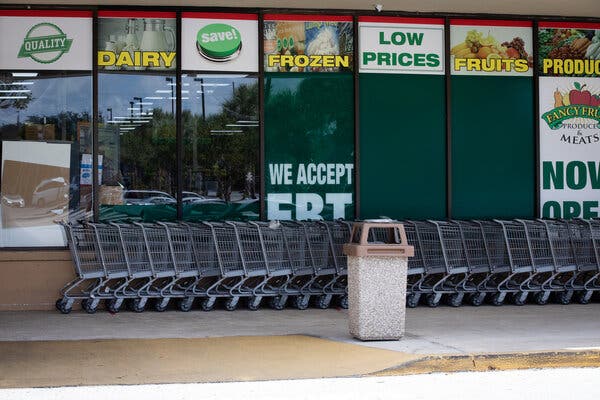transcript
transcript
Frustration at Britain’s Ports Over Travel Restrictions
In Britain, about 4,000 truck drivers were stuck along roads near the southeastern English port in Dover after a 48-hour shutdown to prevent the spread of a variant of the coronavirus. Truckers who want to travel to France must show proof of a negative virus test.
-
“We don’t have food to eat, we don’t have drink, we don’t have anything — nobody don’t care about us.” “But now they say about some Covid test, but there is no Covid test. And I talked with the police officer. He said to me, when you go to the Maidstone. I say to them, how can we go to the Maidstone if the traffic — if the traffic with the trucks — is 200 kilometers?” [shouting] [yelling in distress] [arguing]
Ferries and trains from Britain began arriving in Calais on Wednesday, as France reopened its ports to Britain after a 48-hour shutdown. But the logjam of thousands of Europe-bound trucks stuck in southeast England will take days to clear because drivers must show a negative coronavirus test before they can cross the channel.
The British army was mobilized to help the National Health Service, the country’s health care system, set up facilities to offer rapid coronavirus tests to drivers, who have been stuck in Britain since Sunday night, when France blocked passage to prevent the spread of a variation of the coronavirus that has swept through parts of England. Results from the test are usually available within 30 minutes, although the test is considered unreliable by some health professionals.
As testing sites were being set up Wednesday there was mounting frustration, confusion and skepticism about the plans in Dover. Trucks are parked around the ports, on closed sections of the motorway and at Manston Airport, a closed airfield nearby that has been turned into a giant parking lot for trucks.
Drivers were reportedly told they needed to go to the airport to take the tests, and it took until the afternoon before they were being administered. Drivers who weren’t at the airfield were reluctant to leave their spots in line closer to the border. Frustrations have been building and skirmishes have broken out among drivers, other waiting passengers and the police. One man was arrested after blocking a highway. For most of the day, access to the port was blocked by drivers and other travelers unwilling to move. Later in the day, another testing facility was set up at the port.
Hundreds of other freight drivers lined up along the motorway were told that tests would be administered to them where they were.
Authorities cautioned that it could take days to clear out the more than 5,000 Europe-bound trucks jammed into the area.
“I think it will take a few days to work our way through,” Robert Jenrick, (not Robert Jenkins, as was reported earlier here) a government minister, said on Sky News on Wednesday morning. Any drivers who received a positive test result, he said, would be offered a more accurate test, called a PCR test, which takes longer to process. If that was also positive they would be offered hotel accommodations to self-isolate for 10 days.
Rod McKenzie, the director of policy at Road Haulage Association, which represents the British road transport industry, said there were probably 8,000 to 10,000 trucks in Britain waiting to cross the border.
“It’s a mammoth task,” he told Sky News. “The border is still effectively shut, the testing is effectively not happening.” Some drivers have already spent three nights sleeping in their trucks with limited access to food and toilets.
Trucks in Europe carrying goods to Britain were still allowed to pass this week, but their numbers had declined amid fears that the drivers would be marooned once they crossed into Britain. The German airline Lufthansa flew 80 metric tons of fruit and vegetables from Frankfurt to the north of England on Wednesday for a supermarket supplier that charted the flight. The airline said it was unusual to transport just a cargo of fresh goods on its own.
The crisis at the border has raised concerns about food supplies around the Christmas holidays, because Britain relies on importing fresh fruit and vegetables, especially in the winter.
“It is essential that lorries get moving across the border as quickly as possible,” Andrew Opie of the British Retail Consortium said. “Until the backlog is cleared and supply chains return to normal, we anticipate issues with the availability of some fresh goods.”

New economic data from the federal government on Wednesday highlighted the recovery’s precarious state.
A report from the Commerce Department showed that personal income fell in November for the second straight month and that consumer spending fell for the first time since April.
Separately, the Labor Department said applications for unemployment benefits remained high last week ahead of a new injection of federal aid.
About 869,000 people filed new claims for state jobless benefits. That was down from a week earlier but is significantly above the level in early November, before a surge in coronavirus cases prompted a new round of layoffs in much of the country.
Another 398,000 people filed for Pandemic Unemployment Assistance, one of two federal programs to expand jobless benefits that were set to expire this month without congressional action.
Help may be on the way. After months of delays, Congress on Monday passed a $900 billion economic relief package providing aid to unemployed people, small businesses and most households. Most urgently, it would prevent jobless benefits from expiring at the end of this week for millions of people. But on Tuesday evening, President Trump demanded sweeping changes in the bill, throwing into doubt whether he would sign it.
The data released Wednesday showed the toll that the delays in aid — along with rising virus cases — have taken on the economy. Personal income fell 1.1 percent in November and is down 3.6 percent since July, as waning federal assistance more than offset rising income from wages and salaries. Consumer spending, which helped drive the initial recovery after lockdowns lifted last spring, also faltered, falling 0.4 percent as the weather cooled and virus cases rose. Spending on dining and travel both fell last month, the Commerce Department said.
The income and spending data was just the latest evidence that after rapid gains in the spring and summer, the recovery has stalled and could be going into reverse. Some forecasters expect the December employment report to show a net loss of jobs.
“That huge looming cliff that everyone’s been talking about for months on end, that’s been averted,” said AnnElizabeth Konkel, an economist for the hiring site Indeed. “But there’s no momentum forward. It feels like we’re just stuck. Hopefully the new stimulus package will help get a little more wind in our sails.”
The relief bill was smaller than many economists said was needed to carry the economy through the pandemic and ensure a robust recovery. It won’t revive industries that have been ravaged by the pandemic or undo the damage left by months of lost income for many households.
But the recent deterioration in the economy shows why economists across the ideological spectrum were urging Congress to act quickly even if that meant accepting a smaller bill.
“Without the aid, it seemed like we were on the precipice and there was definitely concern that we could have had a double-dip recession,” said Daniel Zhao, senior economist with the career site Glassdoor. “The position that we find ourselves in now is significantly stronger than where we were even a week ago.”

Even if President Trump signs the relief bill passed by Congress, some jobless workers may temporarily lose their benefits all the same.
The package approved on Monday night extended two federal unemployment programs that were set to expire after this week. But by waiting until the last minute to act, legislators forced state labor departments — which administer both state and federal unemployment benefits — to prepare for the programs’ end. Many states won’t be able to reverse course in time to avoid a lapse in payments.
“People will be treated as if the program ended even though it hasn’t,” said Michele Evermore, senior policy analyst for the National Employment Law Project.
Ms. Evermore said she expected virtually everyone enrolled in either federal program — Pandemic Unemployment Assistance and Pandemic Emergency Unemployment Compensation — to lose benefits at least briefly, although the time will vary by state.
Under the legislation, workers will receive back payments for the weeks they miss.
State employment officials said they had been monitoring developments in Washington and were consulting with the federal Labor Department so that they could move quickly to reinstate benefits. But some affirmed that at least a brief lapse was inevitable.
“There will be a delay in benefits for those currently enrolled,” Jason Moon, a spokesman for Michigan’s Department of Labor and Economic Opportunity, wrote in an email.
The bill also requires people receiving Pandemic Unemployment Assistance to provide documentation showing they lost jobs or earnings because of the crisis. Until now, many workers had been able to assert that they had been affected without offering proof, something critics have said invited fraud.
Ms. Evermore said most legitimate claimants should be able to provide evidence without much difficulty. But she said she worried about the burden that the requirement would put on already strained state unemployment offices, which could make it more difficult for people to receive benefits.
“More chaos in the system right now is just not what we need,” she said.
The new pandemic relief bill includes money to help ensure that no one’s internet is cut off for nonpayment.
The bill would offer up to $50 per month in assistance (or $75 for people living on tribal land) to tens of millions of people with low incomes, including households with a Pell grant recipient or a child qualifying for free school lunch. Also eligible: Everyone who can document a “substantial” decline in income because of a job loss, furlough or successful unemployment benefits application.
It will take at least 60 days for regulators to set rules for the benefit, and it will last only as long as the $3.2 billion in allocations does. If you think you might be eligible, start asking your internet provider about it in January.
The measure includes other provisions to help ease problems with bills: The agreement would provide $25 billion to be distributed through state and local governments to help renters who have fallen behind, and would extend a moratorium on renter evictions through Jan. 31.
Some homeowners may also be protected from foreclosure: Single-family homeowners with loans backed by Fannie Mae or Freddie Mac shielded through at least Jan. 31, regulators said this month. And the Federal Housing Administration, which often insures loans to borrowers who make smaller down payments, said on Monday that it would extend its foreclosure and eviction moratorium through Feb. 28.

There are at least three provisions in the pandemic aid bill related to food stamps.
First, the monthly benefit for SNAP (the official name of the program) would increase by 15 percent through June 30, 2021. As ever, qualification rules remain complex; consult our primer on the eligibility process here.
Second, people collecting unemployment benefits would have an easier time qualifying for SNAP. The bill has language that would exclude those benefits from the income eligibility calculation in many instances.
Finally, college students would have an easier time qualifying. This is also complicated, but people who are eligible for a federal or state work-study program or whose financial aid application yielded an expected family contribution of zero dollars should check to see whether they would be eligible.
College administrators who wish to help students can find more resources on the Hope Center for College, Community and Justice’s website. The center’s director of policy and advocacy, Carrie R. Welton, also posted a Twitter thread with more detail.
By: Ella Koeze·Source: Refinitiv
-
Stocks were higher on Wednesday, with traders on Wall Street seemingly unperturbed by President Trump’s last-minute objection to a stimulus deal, and with European markets bolstered by an agreement that reopened France’s ports to trucks from Britain and expectations that London and Brussels were nearing a Brexit trade deal.
-
On Wall Street, the S&P 500 rose more than half a percent, as investors shook off concerns about the fate of a $900 billion stimulus plan passed by Congress. Mr. Trump on Monday said the deal should provide bigger payments to U.S. taxpayers. The bill passed Congress with overwhelming veto-proof majorities, but Mr. Trump’s last-minute objection potentially undercuts weeks of negotiations that had led to an agreement.
-
The gains also came despite new economic reports that highlighted the fragility of the recovery in the United States. The Commerce Department said personal income fell in November for the second straight month and that consumer spending fell for the first time since April, while the Labor Department said applications for unemployment benefits remained high last week.
-
Shares in Europe were bolstered by reports that a deal between Britain and the European Union could be announced as soon as Wednesday night. Though the talks to reach a Brexit deal by Dec. 31 have repeatedly blown past deadlines, the British pound rose sharply Wednesday.
-
The benchmark Stoxx Europe 600 climbed 1 percent, while the FTSE 100 in Britain was up 0.7 percent, and both rallied late in the trading day as the reports of a deal emerged
-
Also lifting European shares was a late-night deal between Britain and France that reopened the Port of Dover and the Eurotunnel for about 4,000 trucks bound for the mainland that have been stuck in England near the border since Sunday night. France had shut its border to control the spread of a variant of the coronavirus spreading through England.
-
Markets will shut early on Thursday and remain closed on Friday for the holidays. This time of year, the number of trades can be smaller than usual.

The shift to digital work and play from home, hastened by the pandemic, has wreaked havoc on commercial real estate. But experts say it has also generated one surprising bright spot for the industry: data centers.
“You think about data as an intangible asset, but data has to be stored somewhere,” said Milena Petrova, an associate professor at Syracuse University who teaches real estate and corporate finance.
The growing reliance on cloud-based technology — and the big, blocky buildings that house its hardware — has created greater opportunities for developers and investors as businesses and consumers gobble up more data in a world that has become increasingly connected, writes Martha C. White for The New York Times.
And companies that provide data storage are preparing for even greater demand as new technologies like 5G and artificial intelligence become more widely used.
And investors have taken note. “Over the past 90 days, we’re seeing a massive shift in capital toward this industry by big investment funds,” said Andy Cvengros, senior vice president and a member of the technology solutions practice at JLL, a real estate services and investing company.
-
Goldman Sachs announced in October an investment of up to $500 million in data center infrastructure.
-
The private equity firms Blackstone and KKR have recently announced data center investments.
-
Real estate investment trusts focused on data centers delivered returns of 19 percent in the first half of 2020, according to a recent report by JLL.
“It’s an acknowledgment that this is not a niche real estate market anymore,” said Patrick Lynch, senior managing director of the data center solutions group at the real estate services and investment firm CBRE.





